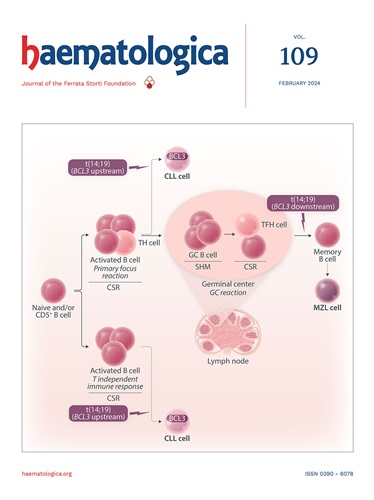Hematopoietic stem cell transplantation is effective in achieving long-term survival for post-aplastic anemia myeloid neoplasms: the EBMT Severe Aplastic Anemia Report.
IF 8.2
1区 医学
Q1 HEMATOLOGY
引用次数: 0
Abstract
Aplastic anemia (AA) transformation into myelodysplastic syndromes (MDS) or acute myeloid leukemia (AML) is associated with a dismal prognosis. Hematopoietic stem cell transplant offers the sole possibility of cure, but data on long-term survival are scarce. We retrospectively analyzed 270 patients transplanted for MDS, AML, or an isolated cytogenetic abnormality after a diagnosis of AA or paroxysmal nocturnal hemoglobinuria reported to the EBMT. The median age at transplantation was 39 years. The 5-year overall survival (OS) rate was 64%, unaffected by chromosome 7 abnormalities, age at transplant, sex, interval from clonal evolution to transplant, and intensity of conditioning regimen. The 5-year non-relapse mortality rates were 34% (95% CI, 25-42%) for MDS patients and 19% (95% CI, 7-31%) for AML patients and were higher following a myeloablative conditioning regimen. The five-year relapse rate was 12% (95% CI, 6-19%) for MDS and 22% (95% CI, 9-35%) for AML. Our study's survival estimates reflect a younger cohort of patients, considering the bimodal distribution of aplastic anemia. Conditioning regimen intensity did not affect relapse. For MDS patients, pretreating before transplant did not improve survival nor reduce relapse. Transplantation is feasible and effective in achieving long-term survival for transplant-eligible post-AA myeloid neoplasm patients. MDS patients may benefit from upfront RIC transplant, limiting toxicity without higher relapse. Posttransplant maintenance therapies to reduce the relapse incidence among AML patients might be warranted.造血干细胞移植对于再生障碍性骨髓肿瘤的长期生存是有效的:EBMT严重再生障碍性贫血报告。
再生障碍性贫血(AA)转化为骨髓增生异常综合征(MDS)或急性髓性白血病(AML)与预后不良相关。造血干细胞移植提供了治愈的唯一可能,但长期存活的数据很少。我们回顾性分析了270例因MDS、AML或单独的细胞遗传学异常而接受移植的患者,这些患者在被诊断为AA或阵发性夜间血红蛋白尿后向EBMT报告。移植时的中位年龄为39岁。5年总生存率(OS)为64%,不受7号染色体异常、移植年龄、性别、从克隆进化到移植的间隔时间和调节方案强度的影响。MDS患者的5年非复发死亡率为34% (95% CI, 25-42%), AML患者的5年非复发死亡率为19% (95% CI, 7-31%),并且在清髓调节方案后更高。MDS的五年复发率为12% (95% CI, 6-19%), AML的五年复发率为22% (95% CI, 9-35%)。考虑到再生障碍性贫血的双峰分布,我们研究的生存估计反映了一个更年轻的患者队列。调理方案强度不影响复发。对于MDS患者,移植前的预处理不能提高生存率,也不能减少复发。移植是可行和有效的实现移植后髓系肿瘤患者的长期生存。MDS患者可能受益于前期RIC移植,限制毒性,且复发率不高。移植后维持治疗以减少AML患者的复发率可能是必要的。
本文章由计算机程序翻译,如有差异,请以英文原文为准。
求助全文
约1分钟内获得全文
求助全文
来源期刊

Haematologica
医学-血液学
CiteScore
14.10
自引率
2.00%
发文量
349
审稿时长
3-6 weeks
期刊介绍:
Haematologica is a journal that publishes articles within the broad field of hematology. It reports on novel findings in basic, clinical, and translational research.
Scope:
The scope of the journal includes reporting novel research results that:
Have a significant impact on understanding normal hematology or the development of hematological diseases.
Are likely to bring important changes to the diagnosis or treatment of hematological diseases.
 求助内容:
求助内容: 应助结果提醒方式:
应助结果提醒方式:


